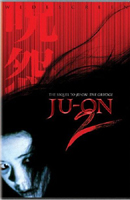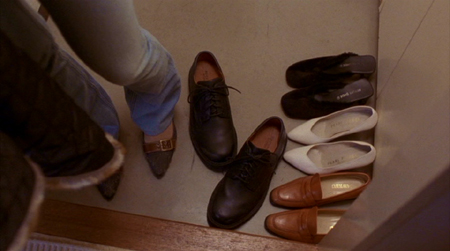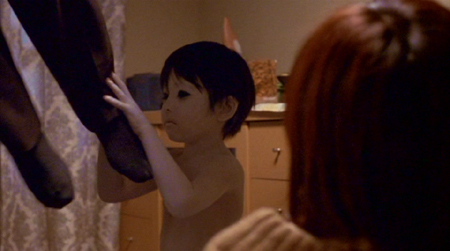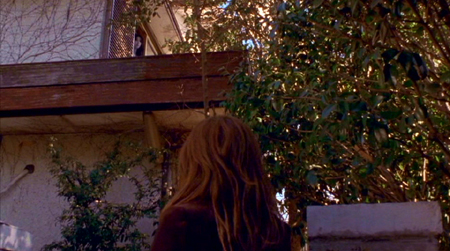 BUY IT AT AMAZON: CLICK HERE!
BUY IT AT AMAZON: CLICK HERE!
STUDIO: LionsGate
MSRP: $26.98
RATED: R
RUNNING TIME: 92 minutes
SPECIAL FEATURES:
• None
The Pitch
“It’s like As I Lay Dying meets Pulp Fiction, with ghosts!”
The Humans
Takako Fuji, Ryoto Koyama, Yuuko Daike
The Nutshell
There is a house in

They’re breeding…
I’m going to be rich.
The Lowdown
I hate to start out with a metaphor, but: hatred is a disease. (Boohoo. I’ll never make poet laureate.) It functions as a sort of plague. It only needs one carrier, and then the symptoms can spread outward from there. Ahab transmits the fallout to his crew; Lucifer is a vector for a third of heaven; and countless ghosts cling to the last of their sickness and spread the suffering as widely as possible.
Ju-On 2 is bound tightly to the story of the original Ju-On, which was itself a fairly simple progression of the haunted house concept, putting a ton of emphasis on the haunted and not so much on the house. A woman and her son were killed there, and their spirits remain, caught between planes because of the intensity of their rage at being snuffed out so cruelly. They don’t venture beyond the threshold of the house, save to torment those who have set foot in their domain. The plague analogy works well, here: imagine the house as one condemned in

If I still had glands, this would be some fun.
This narrows the focus of the plot down to a single geographical location and to those unwitting innocents who intrude upon it. Ju-On 2 isn’t one of those claustrophobic horror stories, though. It’s space may be limited, but its regard of time is expansive. The screenplay is divided into several sections, each focusing on a different one of the characters who visited the house, and each jumbled up in time. Think Pulp Fiction only instead of an arc toward redemption its an arc toward damnation. As each chapter begins, the audience is unsure of where it falls in the timeline. None of the stories exist in a vacuum, fortunately, and the connections that get drawn between them are tight and plain by the end.
Rather than coming of as a gimmick, this post-modern structuring contributes heavily to the mood of the film. By continually returning to a certain point in time, repeatedly leading up to and away from it, a sense of fate, or doom, hangs on every scene. It supports the nature of the ghosts in these films; they aren’t entities to be reasoned with or to hide from or to defeat. They are vicious and they are going to get you. It’s only a matter of time, and director Takashi Shimizu won’t let his audience abandon that wretched time.

You will be shocked! You will be astonished! You will be frightened by a hairpiece!
Kind of secondary to this temporal tomfoolery is a sort of internal looping. In one chapter, a young actress hears a strange thumping against her apartment wall, but can not find the source. It comes to her every night around half-past midnight. It turns out that the cause of these sounds is in the future; she discovers exactly their cause for herself one night, around half-past midnight. These little touches are like the baroque curlicues on a piece of decoration: in their small ways, they contribute to the ambience, but they aren’t the point. In fact, they could easily be distracting to an audience unwilling to go along with a bit of the old Nipponese indulgence in expressionism.
So, mister high-and-mighty here digs the narrative. What about the qualities that makes it a horror flick? There’s a nice, abstract division in horror cinema: the ones that are about punishing people who deserve it; and the ones that are about exploiting the fear that terror is undiscerning in its targets, that it could happen to you as easily as to that bastard who throws paper airplanes at your desk when you’re trying to work. Ju-On 2 falls on the back half. The only transgression these people have made is to trespass on the ghosts’ territory; and even that isn’t really trespassing, except to the Supreme Court of the Shades.

This is my favorite shot in the whole film.
As their sad, unavoidable fates approach, there are plenty of scares to point them in the right direction. The main touchstones have been bandied about the memes quite a bit, now, what with the success of the American remake of the first Ju-On: the pale little kid with the big, black eyes; the awkwardly-moving, croaking woman in the white dress and the ragged hair. There’s not much done to change their identities, here. They appear from weird angles, and in frames you don’t expect them, and are sometimes subtle presences, sometimes blatant. They are silent, except for the dreadful death rattle from the woman, and shot to their maximum potential. Nevertheless, they melt into the general trope of J-horror icons, and do little to distinguish themselves.
That ain’t all bad. Ju-On 2 doesn’t push any boundaries, content-wise, but it holds up its end of the bargain, delivering a solid, creepy atmosphere and the snuffing out of various innocent lives. It’s a satisfying plague horror, in which normal people earn nothing of their punishment, and can field no hope. It’s also satisfying as a puzzle narrative. Its pieces fall into place with little in the way of audience coaxing, so you end up with a complete picture from an aesthetically-pleasing jumble.
No boundaries are pushed, but playing inside the lines works just fine here.

Da-da?
The Package
Nothing. Well, there is a picture. And sound. Both are pretty good. But other than that, nothing.
7.2 out of 10